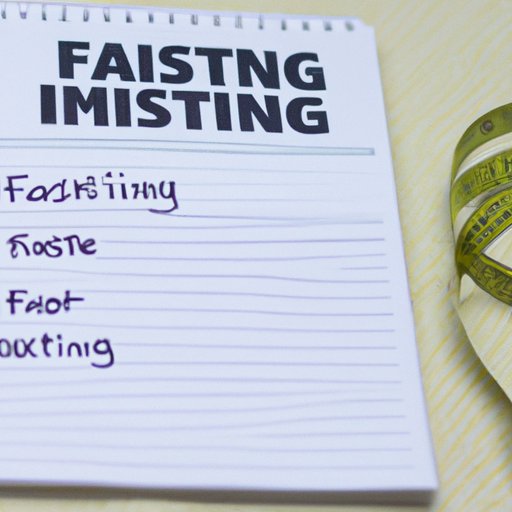
I. Introduction
Fasting is an age-old practice of abstaining from food or drink for a certain period, for various reasons, ranging from religious to health and weight loss reasons. Although it may seem counter-intuitive to starve oneself to lose weight, studies have suggested that intermittent fasting, when done correctly, can be an effective tool for sustainably shedding extra pounds and improving overall health, among other health benefits. In this article, we delve deeper into the world of fasting and provide a beginner’s guide to fasting for weight loss – discussing what it is, its benefits, types, strategies, and mistakes to avoid.
II. The Beginner’s Guide to Fasting: A Step-by-Step Approach to Lose Weight
Fasting involves regulating what, when, and how much one eats over set periods, disrupting the normal eating pattern. It differs from dieting in that it doesn’t restrict food intake; rather, it regulates when and how much to consume. To begin your fasting journey, you need to prepare both mentally and physically. Physically, you would want to consult a doctor to rule out any underlying conditions before starting. Mentally, you need to understand what to expect – things can get challenging at first, and you should be willing to stick with the plan.
First, choose the fasting method that suits you best. The most common ones include:
- Intermittent fasting: involves alternating between cycles of fasting and eating
- Water fasting: involves drinking only water for a set period
- Time-Restricted Feeding: involves limiting your meals to a specific time window, say 6-8 hours per day.
The length of time you fast, as well as what and how much you eat during the non-fasting windows, depends on your level of experience and body needs. Fasting for long periods can be dangerous for some individuals, especially those with certain medical conditions. Therefore, seek medical advice before commencing.
III. Fasting for Weight Loss: Understanding the Different Types and Benefits
Intermittent fasting has recently become popular due to its potential health benefits, including weight loss. When properly executed, it can help the body switch from burning glucose for fuel to burning fat, resulting in weight loss.
A nutritionist can recommend the right type of fasting based on your goals and any underlying conditions. Water fasting, for instance, is weight-loss aggressive but has several risks, including dehydration and nutrient deficiencies. The same applies to time-restricted feeding, whereby you only eat during a small window, which can be challenging in the long term but allows you to consume balanced meals.
IV. Maximizing the Benefits of Fasting for Weight Loss: Tips and Tricks
The key to maximizing the benefits of fasting for weight loss is to plan and monitor everything, including what you eat and when you consume it. To avoid malnutrition, you should consume nutrient-dense foods during your non-fasting periods, and avoid processed and sugary foods as much as possible. Fasting also depletes your body of electrolytes, so stay hydrated throughout by drinking an adequate amount of water.
Finally, maintain balance. Fasting is not a magic bullet, and you’ll need to fuse it with a balanced diet and lifestyle habits to achieve sustainable weight loss. Overeating during non-fasting periods will negate all progress made, so keep a healthy eating plan in mind throughout.
V. Fasting and Exercise: How to Safely and Effectively Incorporate Both for Weight Loss
Exercise and fasting complement each other and can accelerate fat burning while maintaining muscle mass. The first step is to start with light exercises like yoga and build upwards, allowing the body to adjust to the stress levels. Next, aim to space your workout sessions evenly throughout non-fasting periods to improve energy levels, promote muscle growth, and burn stored glucose. That being said, you should avoid strenuous workouts while fasting, as it can lead to fatigue and muscle loss.
VI. Science-Backed Strategies for Fasting to Lose Weight and Maintain a Healthy Lifestyle
Intermittent fasting is known to offer a range of health benefits beyond weight loss, including longevity, improved cognitive function, and decreased inflammation. Research has supported this method, finding that it boosts metabolism, reduces insulin resistance, and improves brain function. Therefore, fasting can be included as part of an overall wellness journey to enhance health and quality of life. Experts recommend staying hydrated, consuming nutritious foods, and getting enough rest, along with fasting, to experience its range of health benefits.
VII. Common Mistakes to Avoid When Fasting for Weight Loss
The challenge with fasting is that it’s challenging to get it right from the start. The mistake that most people make is diving into aggressive fasting without understanding the repercussions, such as hunger, fatigue, and dizziness. Additionally, there’s a temptation to overindulge during non-fasting periods, thereby negating all the effort made. To navigate this, start small and build consistently, monitor what you eat, and keep off stress to stay motivated.
VIII. Conclusion
While fasting for weight loss requires discipline and consistency, it can be a valuable tool in your weight loss journey. However, the objective must be sustainable weight loss and better overall health. This requires adequate planning, monitoring, and an overall healthy lifestyle beyond the fasting period. Therefore, take up fasting with the guidance of a health coach or medical expert, pick the right fasting method that suits you best, and stick to your plan to achieve your weight loss goals.




